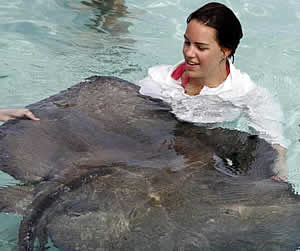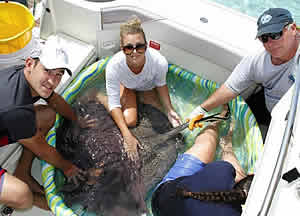
Jessica Harvey rounds up a stingray during the annual census study

Alex Harvey, Louisa Gibson and Dr. Brad Wetherbee secure a large ray in a pool while Tonya Clauss prepares to take blood from the animal.
In mid-July, personnel from the Guy Harvey Research Institute once again collaborated with the Cayman Islands Department of Environment to conduct the annual census of the stingray population in Grand Cayman. This year we were joined by three researchers from the Georgia Aquarium, who were on hand to assist with analyzing the overall health of the stingrays.
The situation at the Sandbar in North Sound is unique, with a large number of wild rays that are not fenced or contained but inhabit the shallow clear water with accessibility every day of the year. The socio-economic value of the rays to the Cayman economy is enormous. On average, each animal can generate up to $500,000 in revenue per year, or $10,000,000 over the course of a 20-year life span!
From a historical perspective, it is worth setting out the track record of research work conducted on the population of stingrays in Grand Cayman. Research was started by the GHRI in 2002 when all the stingrays that frequent the two main sites were caught by hand and tagged with a PIT (passive integrated transponder) at the base of their tail. During the initial count, 164 rays were tagged, weighed and measured at the Sandbar over two years. Since then, tag retention has remained near 100%, so many animals tagged ten years ago still have their PIT today. This has been a very simple and valuable tool to track the life history and growth rates of these animals.
For the period 2002 â€" 2003, one hundred rays were sampled each month over a three-day period at the Sandbar. The same situation was experienced in a subsequent census conducted by the GHRI in 2005 and 2008. As expected, over time there was recruitment of new (untagged) rays to the Sandbar and loss of individuals due to migration, natural mortality and possibly some predation. The sex ratio of 90% females to 10% males has remained fairly constant over this time.
From 2010 tour operators and casual observations indicated a sudden decline in the number of rays at the Sandbar. In response to the reports, the GHRI conducted a census in January 2012 and sampled only 61 rays in the standard three day research period at the Sandbar, which represents a significant (38%) decrease in number of rays compared to the last census in 2008. Now that we had some hard facts to support the eyewitness accounts, the next logical step was to find out what was causing the decline in population.
The numbers of rays have been constant since research was started in 2002 with recruitment and mortality being well balanced. GHRI personnel ruled out predation by sharks in the January census due to lack of evidence of shark bites (near misses) and the corresponding demise of sharks in the last ten years. However, fishing mortality (intentionally or by accident) is a consideration. I say this because here is no national protection for stingrays - outside of the Wildlife Interactive Zones (WIZ) this species has no protection and can be removed and consumed by residents.
Another possibility for us to consider is the overall health of the rays, which is why GHRI enlisted the support of the Georgia Aquarium veterinary staff for this year's census. The addition of the GA vets also allowed the research work to become much more technical. Dr. Tonya Clauss (Director Animal Health, Georgia Aquarium), Dr. Lisa Hoopes (Nutritionist, Georgia Aquarium) and Nicole Boucha (Senior Veterinary Technician, Georgia Aquarium) arrived in Grand Cayman loaded with equipment to take blood and store these precious samples in liquid nitrogen until analysis could be achieved back in Georgia.
Over three days the team sampled 57 rays (only 5 males) at the Sandbar (down from 61 in January) with assistance from DoE staff and several volunteers. The team also spent a day at the original Stingray City and sampled 11 rays (2 males) and caught 3 rays (1 male) at Rum Point, bringing the total to 71 rays sampled. The low number of males in this year's sample is definitely cause for concern.
Each ray was caught by hand and transferred to the pool in the workboat where they were measured and tagged, and then blood was taken from the underside of the base of the tail. Some of this blood was immediately centrifuged to make counts of white blood cells. The rest was frozen in liquid nitrogen for shipment back to the lab in the Georgia Aquarium.
From the blood samples the vets will be able to determine if the (monotonous) diet of squid fed to the rays by the majority of tour operators is affecting the animal's health. The processing of samples and data will take several weeks. At the end of this process we will have more knowledge about these valuable creatures and how better to manage their supplementary diet and well being.
Overall, a long-term plan of monitoring the numbers of rays and their health is required. Everyone in the Cayman Islands benefits from the presence of this unique marine interactive site. Every advertising campaign or tourism related article featuring the Cayman Islands has these iconic animals up front and prominently displayed. It is time the government of the Cayman Islands returned the favor by supporting ongoing research of the stingrays' population status and well being by releasing funds in the Environmental Protection Fund collected for this purpose.
